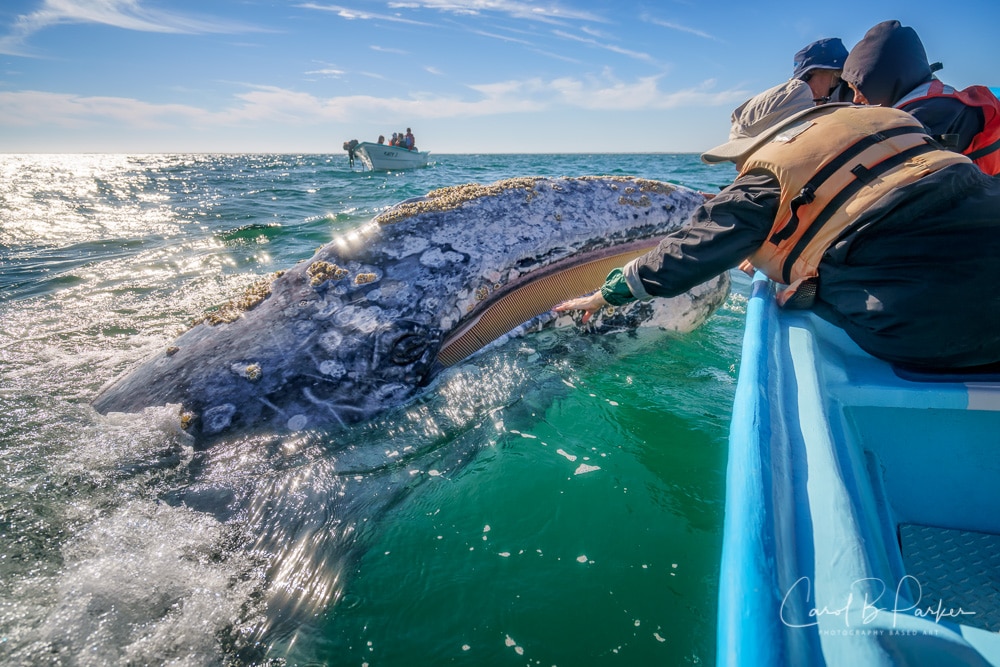Most people have no clue about an amazing phenomenon that takes place every winter in Baja Mexico.
Gray whales migrate 10,000-12,000 miles round trip every year from their summer feeding grounds in the cold Arctic to the winter calving lagoons in Mexico’s warm waters. Beginning in the 1970s or so, the whales of their own volition began to interact with humans.
Imagine the reaction of that first Mexican fisherman, Pachico Mayoral, who was out fishing on the lagoon’s sheltered waters when he was approached by a gray whale. An adult gray whale is about 40 feet long, double the length of Pachico’s fishing panga, and weighs 60,000 pounds. That huge wild creature swam from side to side, exploring the small craft until Mayoral was brave enough to reach down and gently touch the whale. Nothing happened. The whale remained calm. At that moment, an entire ecotourism industry was born, dedicated to introducing humans to whales – touching, petting, even kissing these wild whales!
Let me know if you’d like a referral for the awesome tour company that hosted us in San Ignacio Lagoon. The peak season for whale watching in February and March. Our group camped in tents beside the lagoon, watched spectacular sunsets from our vantage point overlooking the water as whales cruised past, voyaged daily in pangas (traditional Mexican small open fishing boats) to interact with the whales, and on the last day when a massive storm flooded the entire camp and washed out the local airport, we enjoyed a well-orchestrated impromptu adventure through the remote Baja countryside in search of transportation home.
When we visited in February the juveniles were the ones that interacted most with the boats: five, six, and seven-year-old young whales that delighted in gliding along the hull while excited whale watchers leaned over to touch them as they passed by. They opened their mouths, inviting us to touch their tongues. They rolled on their sides to peer up at us with a large intelligent eye. They would sink below the hull and pop up on the other side, teasing us. Then with the flick of a tail, the young whales would race over to another nearby boat to flirt with those whale watchers in turn. Later in the season the protective mothers of the current crop of newborns would relax their guard and bring the babies to the boats, introducing their offspring to the interesting phenomenon of humans floating on top of the water in tiny floating shells.
In addition to whale watching, we enjoyed beach walks, kayak paddles, great food and entertainment in the communal tent, incredible sunsets and rainbows from our oceanfront vantage point, and starlit skies free of light pollution. But on our final night in camp, the heavens opened and drenched us. Tents flooded, porta-potties blew over in the wind, the immaculately groomed pathways lined with seashells turned into a quagmire of mud. In the black of night, I was sloshing around by flashlight in my wet socks piling luggage and camera gear up on our cots to keep everything clear of the lake on the tent floor.
We were scheduled to fly out in the morning, but the charter plane was unable to land on the dirt runway which was no longer dirt but mud. Our organizers heroically scrambled to put the infrastructure back in order and organized alternative transportation back to San Diego (an adventure in itself). Meanwhile, they distracted us with a bonus whale-watching session which was going great until this squall caught up with us!
What is truly amazing is how the behavior of the gray whales has evolved through history. In the 19th century, the whaling industry discovered these nursery lagoons. Whaling ships cut off the entrances, trapping and slaughtering their quarry literally to the point of extinction. In self-defense the whales became fiercely aggressive, attacking their tormentors, smashing the harpoon boats with their tails, or breaching out of the water to land on top of them. How, as the decades passed, did these ‘devil fish’, as the sailors called them, revert from aggression to the charming playfulness they now display? Since whaling days, gray whales have rebounded from the precarious edge of extinction. From a population decimated down to only 100 animals, in today’s world they number some 26,000.
Twenty-plus years ago the giant corporation Mitsubishi and the Mexican government had plans to turn Laguna San Ignacio and the surrounding remote desert into a massive salt-mining concern that would have destroyed this last remaining refuge for the grays. A huge effort by environmentalists in opposition to this plan was launched, ultimately causing the industrial project to be halted and instead enabling the creation of a marine sanctuary. It didn’t hurt that the president of Mexico and his wife visited San Ignacio Lagoon and the wife was able to personally interact with the friendly grays and thereafter influence her husband’s position. In addition, the eco-tourism brings badly needed dollars to the residents of the area, replacing the potential income the salt factory might have produced. All our wild creatures are under threat of extinction. The more humans that care about their fate, the better. Here’s an article about this environmental success story if you’re interested.









